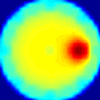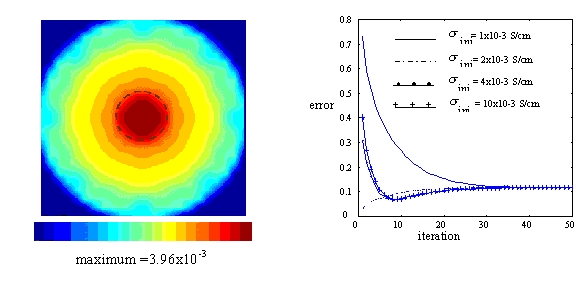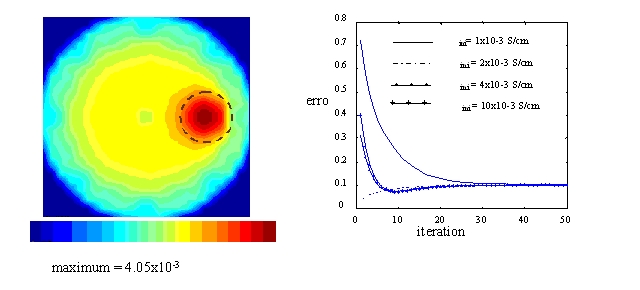 MAGNETIC RESONANCE – ELECTRICAL IMPEDANCE TOMOGRAPHY
MAGNETIC RESONANCE – ELECTRICAL IMPEDANCE TOMOGRAPHY
(MR-EIT): A new technique for high resolution conductivity imaging
In this study, a new imaging modality for high resolution conductivity
imaging is proposed. Both, the surface
potentials and the magnetic fields produced by the probing current
are measured. Surface potentials are measured by
using conventional electrical impedance tomography techniques and high
resolution magnetic field measurements are
performed by using magnetic resonance imaging techniques. The
conductivity distribution is reconstructed iteratively,
to minimise the difference between the current densities calculated
based on the potential measurements and the magnetic
filed measurements. The proposed technique was tested on simulated
data with/without simulated noise and it has been
shown that absolute conductivity images with high resolution can be
reconstructed.
Reconstructed image for a concentric inhomogeneity is given in Figure
1(a). Position of the actual inhomogeity is shown
by dashed lines. Conductivity values of the background region
and the inhomogeneity are 2x10-3 ve 4x10-3 S/cm,
respectively. The image given in Figure 1(a) has been reconstructed
by using a homogeneous conductivity of 1x10-3 S/cm
as an initial guess. Error as a function of iteration is given
in Figure 1(b) for different initial condutivity estimates. All
converges to the same value after approximately 30 iterartions.

(a)
(b)
Figure 1. (a) Reconstructed conductivity image for a concentric
inhomogeneity, position of the actual inhomogenity is
outlined by dashed lines, (b) error as a function of iteration,
as described in equation (6).
Figure 2 (a) and (b) are the reconstructed image and the convergence
plot for an eccentric conductivity distribution.
Again the actual object location is shown by dashed lines. For
both cases the position of the actual object is reconstructed
correctly and the reconstructed values are close to the actual conductivity
of the inhomogeneity after approximately 30 iterations.
The quality of the reconstructed image is independent of the position
of the inhomogeneity. However, in both cases the
background conductivity is under estimated close to the electrodes.
This results in an increased overall error. Reducing the
FE grid size close to the electrodes may reduce this error.

(a)
(b)
Figure 5. (a) Reconstructed conductivity image for a eccentric
inhomogeneity, position of the actual inhomogenity is
outlined by dashed lines, (b) error as a function of iteration,
as described in equation (6).
To investigate the noise performance of the proposed algorithm, simulated
Gaussian noise with various standard deviations
is added to the potentail data and the magnetic field data prior to
the reconstruction. When noise with a maximum equal
to 10% of the maximum potential measurement is added to the potential
measurements and noise with a maximum equal
to 10% of the maximum magnetic field measurement is added to the magnetic
field measurements, the iteration error (as
defined by equation (6) ) is 24% for the eccentric inhomogeneity case,
when the convergence is achieved. Better results
obtained when the noise is added to only the potential or the magnetic
field measurements and when the inhomogeneity is
concentric.
Acknowlegment: This work is supported by Turkish Scientific
and Technical Research Council (TUBITAK) Research
Grant EEEAG-198006.
References:
O. Birgul, O. Ozbek, B.M. Eyuboglu and Y.Z. Ider, "Magnetic Resonance
Conductivity Imaging Using 0.15 Tesla MRI Scanner," Proceedings (CD-ROM)
of the IEEE/EMBS 23rd Annual Conference, Istanbul - Turkey, 2001.
article.pdf
B.M. Eyuboglu, O. Birgul, and Y.Z. Ider, "A Dual Modality System for
High Resolution - True Conductivity Imaging," Proccedings of
XIth International Conference on Electrical Bio-impedance, Oslo - Norway,
pp. 409-413, 2001.
O. Birgul, B.M. Eyuboglu, and Y.Z. Ider, "New Technique for High-Resolution
Absolute Conductivity Imaging Using Magnetic Resonance Electrical Impedance
Tomography (MR-EIT)," in Medical Imaging 2001 : Physics of Medical Imaging,
Proc. of SPIE Vol. 4320, pp.880-888, 2001. article.pdf
B.M. Eyuboglu, O. Birgul, and Y.Z. Ider, "Magnetic Resonance - Electrical
Impedance Tomography (MR-EIT): A new technique for high resolution conductivity
imaging," Proceedings of the Second EPSRC Engineering Network Meeting on
Biomedical Applications of EIT, London - U.K., pp.76-79, 2000.
B.M. Eyuboglu, Ravinder Reddy and John S. Leigh "Imaging Electrical
Current Density Using Nuclear Magnetic Resonance," Elektrik, Vol.6,
No.3, 1998. article.pdf